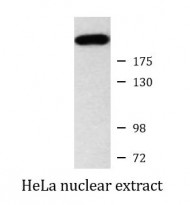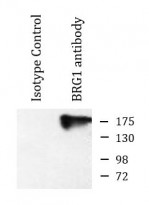ARG54166
anti-BRG1 antibody
anti-BRG1 antibody for ICC/IF,Immunoprecipitation,Western blot and Human,Mouse
Cancer antibody; Developmental Biology antibody; Gene Regulation antibody; Neuroscience antibody; Signaling Transduction antibody
Overview
| Product Description | Mouse Monoclonal antibody recognizes BRG1. |
|---|---|
| Tested Reactivity | Hu, Ms |
| Tested Application | ICC/IF, IP, WB |
| Host | Mouse |
| Clonality | Monoclonal |
| Isotype | IgG1 |
| Target Name | BRG1 |
| Antigen Species | Human |
| Immunogen | Purified recombinant human BRG1 protein fragments expressed in E.coli. |
| Conjugation | Un-conjugated |
| Alternate Names | BRG1-associated factor 190A; SNF2-beta; RTPS2; SNF2L4; SWI/SNF-related matrix-associated actin-dependent regulator of chromatin subfamily A member 4; Transcription activator BRG1; BAF190A; EC 3.6.4.-; Protein BRG-1; SNF2LB; ATP-dependent helicase SMARCA4; MRD16; BAF190; Mitotic growth and transcription activator; BRG1; Protein brahma homolog 1; SNF2; hSNF2b; SWI2 |
Application Instructions
| Application Suggestion |
|
||||||||
|---|---|---|---|---|---|---|---|---|---|
| Application Note | * The dilutions indicate recommended starting dilutions and the optimal dilutions or concentrations should be determined by the scientist. | ||||||||
| Observed Size | 220 kDa |
Properties
| Form | Liquid |
|---|---|
| Purification | Affinity purified |
| Buffer | PBS (pH 7.4), 0.02% Sodium azide and 50% Glycerol |
| Preservative | 0.02% Sodium azide |
| Stabilizer | 50% Glycerol |
| Concentration | 1.4 mg/ml |
| Storage Instruction | For continuous use, store undiluted antibody at 2-8°C for up to a week. For long-term storage, aliquot and store at -20°C. Storage in frost free freezers is not recommended. Avoid repeated freeze/thaw cycles. Suggest spin the vial prior to opening. The antibody solution should be gently mixed before use. |
| Note | For laboratory research only, not for drug, diagnostic or other use. |
Bioinformation
| Database Links | |
|---|---|
| Gene Symbol | SMARCA4 |
| Gene Full Name | SWI/SNF related, matrix associated, actin dependent regulator of chromatin, subfamily a, member 4 |
| Background | Transcriptional coactivator cooperating with nuclear hormone receptors to potentiate transcriptional activation.Component of the CREST-BRG1 complex,a multiprotein complex that regulates promoter activation by orchestrating a calcium-dependent release of a repressor complex and a recruitment of an activator complex.In resting neurons,transcription of the c-FOS promoter is inhibited by BRG1-dependent recruitment of a phospho-RB1-HDAC repressor complex.Upon calcium influx,RB1 is dephosphorylated by calcineurin,which leads to release of the repressor complex.At the same time,there is increased recruitment of CREBBP to the promoter by a CREST-dependent mechanism,which leads to transcriptional activation.The CREST-BRG1 complex also binds to the NR2B promoter,and activity-dependent induction of NR2B expression involves a release of HDAC1 and recruitment of CREBBP.Belongs to the neural progenitors-specific chromatin remodeling complex (npBAF complex) and the neuron-specific chromatin remodeling complex (nBAF complex).During neural development a switch from a stem/progenitor to a post-mitotic chromatin remodeling mechanism occurs as neurons exit the cell cycle and become committed to their adult state.The transition from proliferating neural stem/progenitor cells to post-mitotic neurons requires a switch in subunit composition of the npBAF and nBAF complexes.As neural progenitors exit mitosis and differentiate into neurons,npBAF complexes which contain ACTL6A/BAF53A and PHF10/BAF45A,are exchanged for homologous alternative ACTL6B/BAF53B and DPF1/BAF45B or DPF3/BAF45C subunits in neuron-specific complexes (nBAF).The npBAF complex is essential for the self-renewal/proliferative capacity of the multipotent neural stem cells.The nBAF complex along with CREST plays a role regulating the activity of genes essential for dendrite growth.SMARCA4/BAF190A may promote neural stem cell self-renewal/proliferation by enhancing Notch-dependent proliferative signals,while concurrently making the neural stem cell insensitive to SHH-dependent differentiating cues by similarity.Also involved in vitamin D-coupled transcription regulation via its association with the WINAC complex,a chromatin-remodeling complex recruited by vitamin D receptor (VDR), which is required for the ligand-bound VDR-mediated transrepression of the CYP27B1 gene.Acts as a corepressor of ZEB1 to regulate E-cadherin transcription and is required for induction of epithelial-mesenchymal transition (EMT) by ZEB1. |
| Function | Transcriptional coactivator cooperating with nuclear hormone receptors to potentiate transcriptional activation. Component of the CREST-BRG1 complex, a multiprotein complex that regulates promoter activation by orchestrating a calcium-dependent release of a repressor complex and a recruitment of an activator complex. In resting neurons, transcription of the c-FOS promoter is inhibited by BRG1-dependent recruitment of a phospho-RB1-HDAC repressor complex. Upon calcium influx, RB1 is dephosphorylated by calcineurin, which leads to release of the repressor complex. At the same time, there is increased recruitment of CREBBP to the promoter by a CREST-dependent mechanism, which leads to transcriptional activation. The CREST-BRG1 complex also binds to the NR2B promoter, and activity-dependent induction of NR2B expression involves a release of HDAC1 and recruitment of CREBBP. Belongs to the neural progenitors-specific chromatin remodeling complex (npBAF complex) and the neuron-specific chromatin remodeling complex (nBAF complex). During neural development a switch from a stem/progenitor to a post-mitotic chromatin remodeling mechanism occurs as neurons exit the cell cycle and become committed to their adult state. The transition from proliferating neural stem/progenitor cells to post-mitotic neurons requires a switch in subunit composition of the npBAF and nBAF complexes. As neural progenitors exit mitosis and differentiate into neurons, npBAF complexes which contain ACTL6A/BAF53A and PHF10/BAF45A, are exchanged for homologous alternative ACTL6B/BAF53B and DPF1/BAF45B or DPF3/BAF45C subunits in neuron-specific complexes (nBAF). The npBAF complex is essential for the self-renewal/proliferative capacity of the multipotent neural stem cells. The nBAF complex along with CREST plays a role regulating the activity of genes essential for dendrite growth. SMARCA4/BAF190A may promote neural stem cell self-renewal/proliferation by enhancing Notch-dependent proliferative signals, while concurrently making the neural stem cell insensitive to SHH-dependent differentiating cues (By similarity). Acts as a corepressor of ZEB1 to regulate E-cadherin transcription and is required for induction of epithelial-mesenchymal transition (EMT) by ZEB1. [UniProt] |
| Cellular Localization | Nucleus |
| Research Area | Cancer antibody; Developmental Biology antibody; Gene Regulation antibody; Neuroscience antibody; Signaling Transduction antibody |
| Calculated MW | 185 kDa |
Images (3) Click the Picture to Zoom In
-
ARG54166 anti-BRG1 antibody ICC/IF image
Immunofluorescence: HeLa cells fixed with 4% Paraformaldehyde and stained with ARG54166 anti-BRG1 antibody at 1:50 dilution.
-
ARG54166 anti-BRG1 antibody WB image
Western blot: HeLa nuclear extract stained with ARG54166 anti-BRG1 antibody at 1:1000 dilution.
-
ARG54166 anti-BRG1 antibody IP image
Immunoprecipitation: K562 cell lysates were immunoprecipitated and stained with ARG54166 anti-BRG1 antibody.








